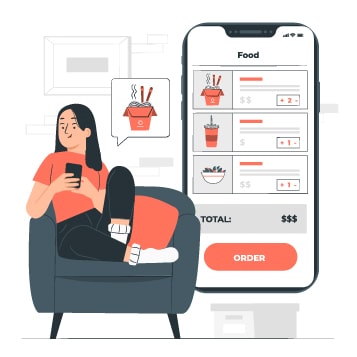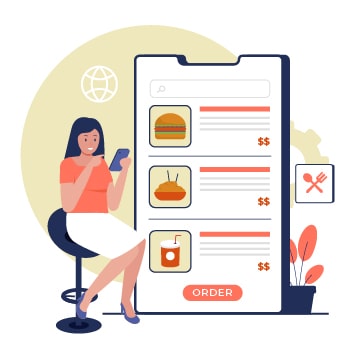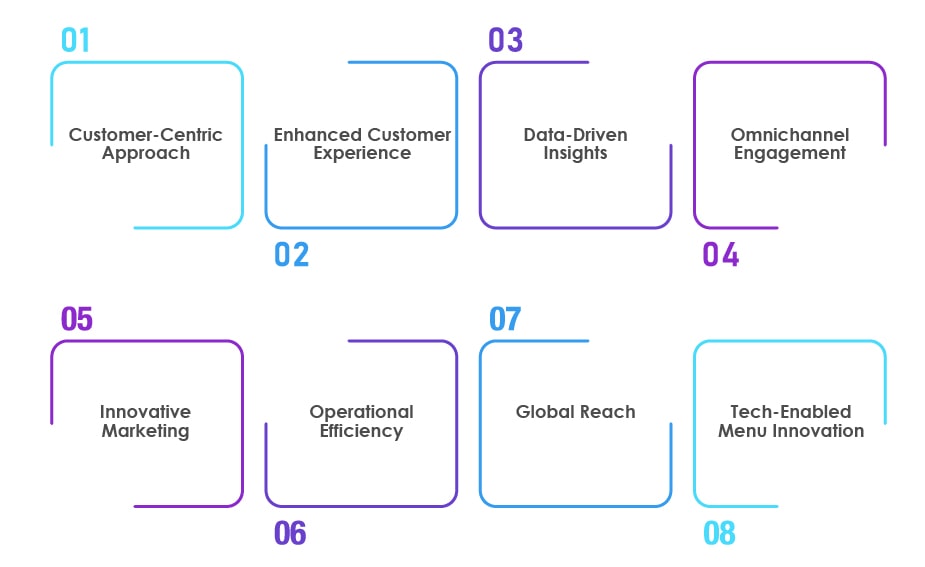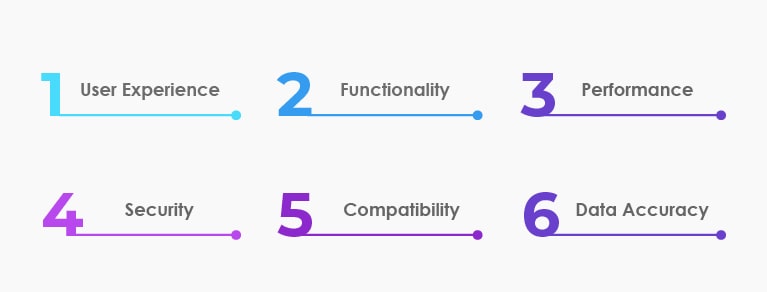
An Overview of the QSR Industry

In response to the demand for speedy preparation and delivery of food and beverages, quick-service restaurants were created. A prime example of a QSR or quick food restaurant is McDonald’s. In the 1930s, when Richard and Maurice McDonald came to San Bernardino, California, they opened a tiny drive-in restaurant there called McDonald’s Bar-B-Q.
The eatery became well-known for its ground-breaking “Speedee Service System,” which employed an assembly-line-style cooking method to swiftly and effectively prepare burgers, fries, and other menu items. A more relaxed and comfortable dining experience was intended to be provided by traditional full-service restaurants, which would provide full table service and a wider selection of menu items.
With time, the landscape of the Quick Service Restaurant (QSR) sector experienced a profound evolution due to technological advancements. Technology is significantly influencing the QSR trends relating to its operations, ordering and payment processes, kitchen machinery, and promotional approaches, fundamentally reshaping the methods by which QSRs conduct their operations.
QSR Industry in the 21st Century

As per Zion Market Research, statistics reveal that the global size of the fast-food market reached $647.7 billion in 2021 and is projected to exceed $998 billion by the conclusion of 2028, exhibiting a compound annual growth rate of 4.6% throughout the forecast period.
Nonetheless, expansion is accompanied by a distinct array of difficulties. Within the QSR sector, the major challenges include cut-throat competition from both emerging and well-established participants, as well as a decline in customer loyalty towards fast-food labels.
Modern customers show a growing preference for brands that introduce innovation into their products and provide meaningful experiences that resonate with their lifestyles. For Quick Service Restaurant (QSR) chains, mastering this aspect can lead to the establishment of customer loyalty, increased sales, and unprecedented profit growth. This is precisely where the assistance of technology, particularly data analytics, becomes indispensable.
How the digital-first mentality is Impacting QSRs

The digital-first mentality is poised to have a profound impact on Quick Service Restaurants (QSRs) and the trajectory of their digital transformation. This shift represents a fundamental change in how QSRs approach their operations, customer engagement, and overall business strategy.
Customer-Centric Approach:
The digital-first mentality places the customer at the heart of QSR business operations. The popularity of smartphones and online platforms has raised client expectations for convenient, tailored services. To meet this demand, QSRs will need to adapt by providing smart mobile apps, user-friendly websites, and frictionless online ordering alternatives.
Enhanced Customer Experience:
QSRs can offer improved customer experiences by adopting a digital-first strategy. Self-service kiosks, mobile order-ahead functionality, and contactless payments are examples of such services. These advancements make dining faster and more pleasurable while minimizing mistakes and waiting periods.
Data-Driven Insights:
The digital-first strategy makes it easier to get useful customer data. This data can be analyzed by QSRs to learn more about customer preferences, ordering patterns, and peak times. Menu optimization, targeted marketing initiatives, and wise business choices are all influenced by this data.
Omnichannel Engagement:
QSRs can engage customers across multiple channels, blurring the lines between in-store, online, and mobile experiences. This allows customers to seamlessly transition from one touchpoint to another, such as ordering online and picking up in-store, fostering greater convenience.
Innovative Marketing:
digital-first mentality opens the door to innovative marketing strategies. QSRs can leverage social media, influencer partnerships, and location-based advertising to reach customers in novel ways and drive foot traffic to their establishments.
Operational Efficiency:
QSRs can leverage digital tools for more efficient operations. Inventory management systems can be automated, minimizing wastage and ensuring items are always in stock. Staff scheduling can be optimized based on historical sales data and foot traffic patterns.
Global Reach:
QSRs can broaden their reach beyond physical locations by adopting a digital-first strategy. Online ordering and delivery services have the potential to reach customers outside of their immediate area.
Tech-Enabled Menu Innovation:
QSRs can experiment with new menu items, seasonal specials, and limited-time offers. Digital platforms allow for rapid testing and instant feedback from customers.
The digital-first mentality is reshaping the QSR landscape by revolutionizing customer experiences, operational efficiency, marketing strategies, and overall business agility. QSRs embrace this shift and invest in their digital transformation stand to reap significant rewards in terms of customer loyalty, growth, and long-term success.
Top 5 QSR Trends Driving Digital Transformation in 2024

Digital Drive-Thrus
As pointed out by Brian Geraghty, who leads Restaurant Finance at Mitsubishi UFJ Financial Group, Quick Service Restaurants (QSRs) that weathered the pandemic have redirected their attention towards bolstering their drive-thru and takeout services. This trend was observable as far back as October 2020 when reports emerged that Burger King, Popeyes, and Tim Hortons were gearing up to enhance over 10,000 drive-thrus in the subsequent year to benefit from the booming customer interest in drive-thru food experiences.
Reports from industry publications highlighted that more than 40,000 digital screens are undergoing installation in drive-thru setups. These screens are set to provide customers with advanced technological functionalities, including:
1. Utilizing Artificial Intelligence for Predictive Selling:
The parent company, Restaurant Brands International, stated that their technology has the capability to intelligently grasp customers’ preferred ordering patterns and display trending menu selections tailored to the specific location. This innovative approach enables the customization of special promotions for individual customers, taking into account their past orders, local weather conditions, time of day, and other relevant factors.
2. Enabling remote and contactless transactions:
The digital drive-thru menu boards have the capability to seamlessly incorporate instant and remote contactless payment methods. This allows customers to place their orders and make payments simultaneously without the need for physical contact.
3. Incorporation of loyalty programs through Bluetooth, scanning, or near-field communication:
The updated menu boards can seamlessly integrate loyalty programs, allowing the menu choices presented to be personalized based on a customer’s preferred selections and their history of redemptions.
IoT in the Kitchen
The world of Quick Service Restaurants (QSR) is no stranger to innovation, and one of the most exciting trends reshaping the industry today is the integration of the Internet of Things (IoT) in the kitchen.
1. Smart Appliances:
Traditional kitchen equipment is getting a high-tech makeover. Smart fryers, ovens, and grills are now equipped with sensors and connectivity, enabling real-time monitoring and control. This ensures that food is cooked to perfection, reduces energy consumption, and minimizes downtime.
2. Inventory Management:
IoT-powered sensors are keeping a close eye on ingredients and supplies. They automatically track stock levels, expiration dates, and reorder when necessary. This not only prevents food wastage but also streamlines supply chain management, making sure your favorite QSR items are always in stock.
3. Delivery Optimization:
IoT plays a crucial role in delivery services. GPS trackers on delivery vehicles ensure efficient routing, reducing delivery times and fuel consumption. Smart temperature sensors maintain the quality of the food during transit, guaranteeing a hot and fresh meal upon arrival.
4. Security and Safety:
IoT technologies enhance safety protocols in the kitchen. Smoke detectors, fire suppression systems, and even wearable tech for staff can detect potential hazards and respond swiftly, ensuring a safer working environment.
Omnichannel Payments
In the ever-evolving landscape of Quick Service Restaurants (QSRs), staying at the forefront of technology is essential. One of the most influential trends driving digital transformation in the QSR industry is the adoption of omnichannel payments.
1. Seamless Ordering and Payment:
Omnichannel payments enable customers to order and pay for their meals across various platforms, including mobile apps, websites, kiosks, and even through voice-activated assistants. This flexibility allows customers to choose their preferred ordering method, making the process smoother and more convenient.
2. Curbside and Drive-Thru Convenience:
Omnichannel payments extend to curbside pickup and drive-thru services. Customers can place their orders ahead of time, pay online, and then pick up their food without leaving their cars. This reduces wait times, enhances efficiency, and improves the overall customer experience.
3. Contactless Payments:
The rise of mobile wallets, NFC technology, and QR codes has ushered in an era of contactless payments. QSRs are leveraging these options to offer a secure and hygienic payment experience, aligning with the changing preferences of customers in a post-pandemic world.
4. Data-Driven Personalization:
With omnichannel payments, QSRs collect valuable customer data that can be used to create personalized offers and recommendations. By analyzing purchase history and preferences, QSRs can tailor promotions, increasing customer loyalty and sales.
Ghost Kitchens
Quick Service Restaurants (QSRs) are no strangers to innovation, and one of the most intriguing trends reshaping the industry today is the rise of Ghost Kitchens. These digital-first culinary hubs are changing the game in how we experience and enjoy our favourite fast-food delights.
1. Digital-First Approach:
Ghost Kitchens thrive in the digital realm. They heavily rely on online ordering platforms, mobile apps, and third-party delivery services. Customers can explore a diverse array of food options from various brands in one virtual space and order with just a few taps on their smartphones.
2. Local and Global Expansion:
These digital kitchens can pop up in strategic locations, bringing diverse cuisines to neighborhoods that may not have had access to such options before. Moreover, Ghost Kitchens can easily expand their reach to different regions or countries, bridging culinary gaps and catering to a global audience.
3. Chef Collaboration:
Ghost Kitchens often collaborate with celebrity chefs, popular food influencers, or emerging culinary talents. These partnerships bring fresh and exciting flavors to the virtual table, attracting foodies seeking unique dining experiences.
4. The Future of Dining:
Ghost Kitchens are not just a trend; they represent the future of dining in a fast-paced, digitally connected world. They offer convenience, variety, and accessibility, making it easier than ever for customers to savor their favorite meals without leaving the comfort of their homes.
Automated Inventory Management
Managing inventory efficiently is crucial for success in the fast-paced world of Quick Service Restaurants (QSRs). Automated inventory management systems have emerged as a game-changer in this sector. These systems streamline tracking and managing stock, ensuring that restaurants can operate smoothly and meet customer demands effectively.
Real-Time Inventory Tracking: In the fast-paced environment of Quick Service Restaurants (QSRs), real-time inventory tracking is a critical feature of automated inventory management systems. It allows managers to instantly view current stock levels, substantially reducing the risks of overstocking or shortages. This capability is crucial for making informed decisions regarding ordering and stock rotation, ensuring that the restaurant is always prepared to meet customer demands.
Reduction in Manual Labor and Errors: Automated inventory management significantly reduces manual labor and the potential for human errors. By automating tasks such as stock counting and data recording, these systems enhance the accuracy and efficiency of inventory management. This reduction in manual intervention saves time and ensures precision in stock handling and record-keeping.
Seamless System Integration: Another major advantage of automated inventory systems is their integration with other operational systems, like point-of-sale (POS) and supply chain management. This integration offers a holistic view of the restaurant’s operations, optimizing stock levels based on real-time sales data and consumption patterns. This interconnectedness is key to maintaining efficiency and responsiveness in the fast-paced QSR industry.
Cost Savings and Improved Operational Efficiency: Automated inventory management in QSRs leads to significant cost savings and enhanced operational efficiency. By accurately managing stock levels, restaurants can minimize waste and reduce unnecessary expenses. This streamlined approach saves resources and boosts the establishment’s operational effectiveness.
Importance of Testing the QSR Apps and Websites

Testing Quick Service Restaurant (QSR) apps and websites holds immense significance in ensuring a seamless and satisfying digital experience for both customers and the business itself. In the modern era, where digital interactions are paramount, rigorous testing safeguards against potential pitfalls that can tarnish a brand’s reputation and customer loyalty.
User Experience:
Ensuring a seamless and user-friendly experience is paramount for QSR apps and websites. Testing helps identify usability issues, navigation problems, and design flaws that could frustrate customers and lead to poor user experience. A positive user experience can encourage repeat business and customer loyalty.
Order Accuracy:
QSR apps and websites often involve complex ordering processes with various customization options. Testing ensures that customers can accurately place their orders, customize them according to their preferences, and receive the correct items. Order accuracy is essential to meet customer expectations and reduce the number of complaints and refunds.
Performance:
Users expect QSR apps and websites to be fast and responsive. Testing helps identify and rectify performance bottlenecks, such as slow page load times, unresponsive buttons, or crashes. A smooth and responsive app or website can enhance customer satisfaction and encourage frequent usage.
Security:
QSR apps and websites handle sensitive customer information, including payment details. Security testing is crucial to identify vulnerabilities, prevent data breaches, and protect customer data. A breach not only compromises customer trust but can also result in legal and financial consequences for the restaurant.
Compatibility:
QSR apps and websites should function correctly on various devices and browsers. Testing helps ensure compatibility across different platforms (e.g., iOS, Android, web browsers) and screen sizes, allowing the restaurant to reach a broader audience and maximize customer reach.
Competitive Advantage:
In a highly competitive market, QSRs that offer a flawless digital experience through their apps and websites gain a competitive edge. Testing helps maintain and enhance the quality of the digital platform, attracting more customers and outperforming competitors.
The accuracy and reliability of these digital platforms significantly impact customer trust and business credibility. Testing plays a pivotal role in validating the accuracy of menu items, prices, and nutritional information. In an industry where precision matters, any errors in this realm can lead to customer dissatisfaction and potential legal complications. Regular testing also ensures that online ordering and payment processes are secure and user-friendly, guarding against potential data breaches and fraudulent activities. By consistently evaluating the performance, security, and user experience of their apps and websites, QSRs can remain competitive in a tech-driven landscape, attract and retain customers, and ultimately bolster their brand’s digital presence and profitability.
Conclusion
In the dynamic realm of Quick Service Restaurants (QSRs), the digital transformation journey is unveiling a landscape of innovative possibilities. As we delve into the trends shaping the industry in 2024, it’s evident that technology is becoming an integral force driving operational efficiency, customer engagement, and overall success. From the surge in ghost kitchens and virtual brands to the embrace of contactless payments and personalized experiences, QSRs are strategically adapting to meet the evolving preferences and expectations of modern consumers.
The convergence of data analytics, smart devices, and intuitive applications is not only enhancing customer experiences but also providing QSRs with actionable insights to refine their strategies and offerings. As digital drive-thrus emerge as a game-changer, optimizing every aspect of the ordering process, and IoT finds its foothold in kitchens, the path ahead holds exciting potential for both established QSR giants and emerging players.
As we navigate this landscape of transformation, it’s clear that the fusion of innovation and customer-centricity is the cornerstone of success. By harnessing these trends, QSRs can continue to meet the demands of today’s tech-savvy consumers, create memorable dining experiences, and solidify their place in an ever-evolving industry. The journey towards a tech-driven future is not just a necessity; it’s an opportunity for QSRs to shape the way we enjoy food and redefine convenience in the years to come.
How Can TestingXperts help you with the QSR Apps?

TestingXperts can be your invaluable partner in ensuring the seamless and robust performance of your Quick Service Restaurant (QSR) digital services. With our expertise in software testing and quality assurance, we offer a range of services tailored to meet the unique demands of QSR digital platforms. Here’s how we can assist you:
Comprehensive Testing Solutions:
Our team specializes in end-to-end testing of QSR apps, websites, and digital solutions. We conduct functional, usability, performance, security, and compatibility testing to ensure your digital services meet the highest standards.
User Experience Enhancement:
We meticulously analyze the user experience to identify pain points, inconsistencies, and areas for improvement. This helps in creating an intuitive and seamless journey for your customers, boosting engagement and satisfaction.
Performance Optimization:
With our performance testing services, we assess how your digital services handle various loads and conditions. This ensures that even during peak usage, your platforms remain responsive and efficient.
Continuous Testing:
Through automated testing solutions, we help you maintain the highest quality standards as your digital services evolve. This ensures that each update, feature addition, or change is thoroughly tested without disrupting the user experience.
End-to-End Support:
From initial testing to ongoing maintenance, we offer continuous support to ensure your QSR digital services maintain their high quality and remain competitive.
By partnering with TestingXperts, you can focus on delivering exceptional dining experiences while we ensure the seamless operation, security, and performance of your QSR digital platforms.
Discover more
Get in Touch
Stay Updated
Subscribe for more info




